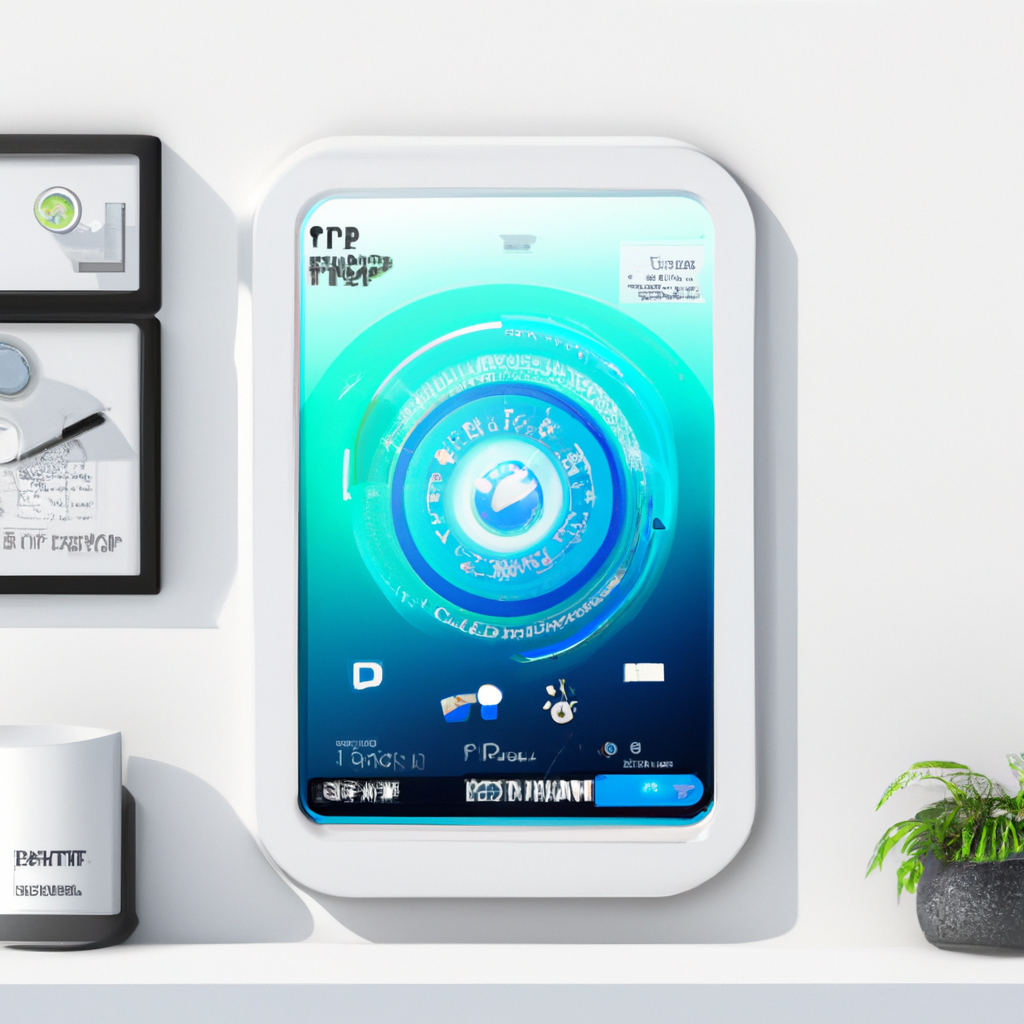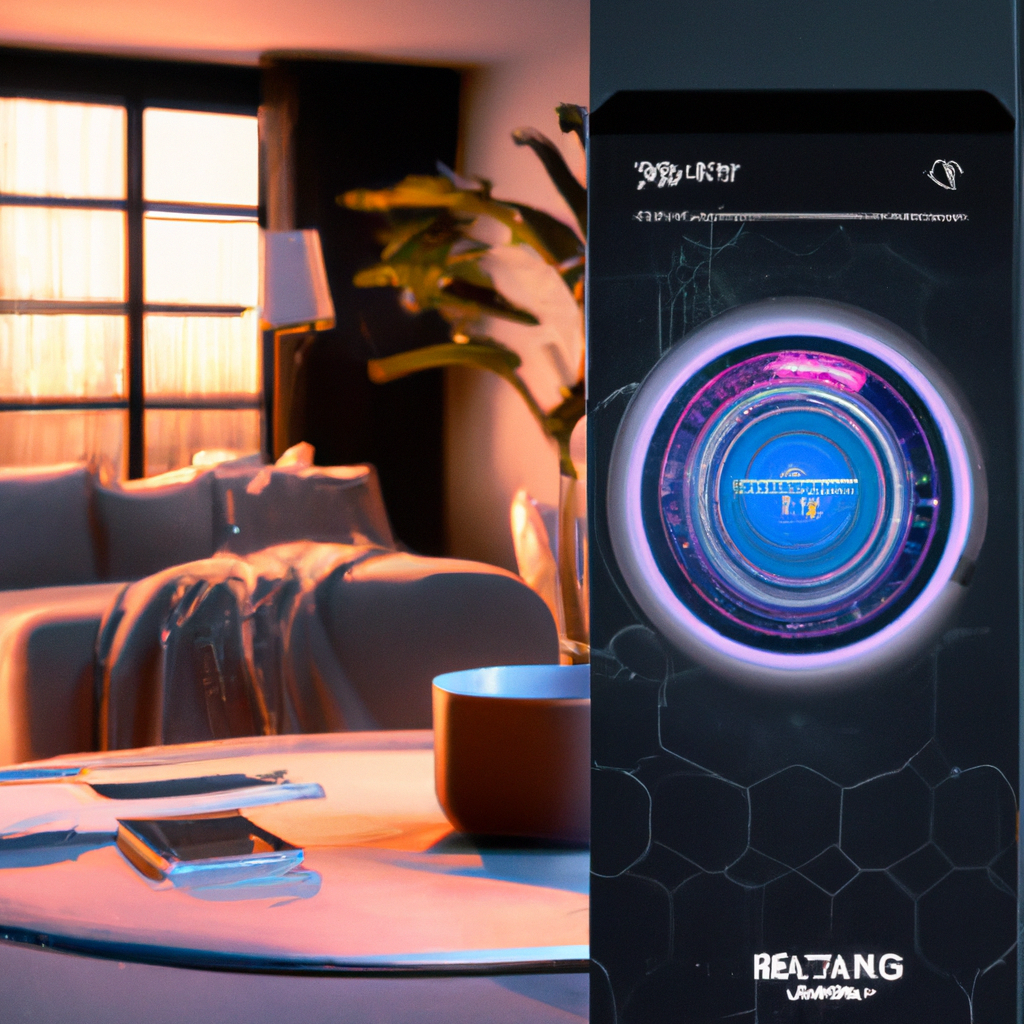Imagine having complete control over your home’s temperature, even when you’re not there. A smart thermostat can do just that and so much more. By intelligently learning your preferences and adjusting the temperature accordingly, it ensures maximum comfort while minimizing energy waste. With real-time data and remote access through your smartphone, you will have the power to optimize your energy consumption and reduce those hefty energy bills. Let’s explore the many ways a smart thermostat can revolutionize your home and help you save money in the process.

Understand Your Energy Usage
Monitor Your Energy Consumption
A smart thermostat can help you understand your energy usage by providing real-time information about how much energy your HVAC system is consuming. Through the smart thermostat’s user-friendly interface or mobile app, you can keep track of your energy consumption on a daily, weekly, or monthly basis. By being aware of your energy usage patterns, you can make informed decisions on how to optimize your energy consumption.
Identify Energy-Wasting Patterns
With a smart thermostat, you can identify energy-wasting patterns in your home. The device records and analyzes data about your temperature preferences, occupancy patterns, and heating or cooling habits. By collecting this information, the smart thermostat can detect trends and provide insights into where energy is being wasted. For example, the device may indicate that you’re consistently heating or cooling empty rooms or that your thermostat is set too high or low during certain times of the day. Armed with these insights, you can make adjustments to your settings and reduce energy waste.
Set Energy Saving Goals
One of the greatest benefits of using a smart thermostat is the ability to set energy-saving goals. With this feature, you can establish targets for reducing your energy consumption and track your progress over time. For instance, you may want to decrease your monthly energy usage by a certain percentage or aim to keep your heating or cooling costs within a specific budget. By setting these goals, you’ll be motivated to take proactive steps to save energy, such as adjusting your temperature settings, utilizing energy-saving modes, or optimizing your scheduling preferences.
Optimize Temperature Control
Programmable Temperature Settings
A smart thermostat allows you to optimize temperature control by providing programmable settings. This means you can create a personalized schedule for your HVAC system to automatically adjust the temperature based on your preferences and occupancy patterns. For example, you can program the thermostat to lower the temperature when you’re away from home and raise it just before you return. By optimizing your temperature control, you can ensure that your home is comfortable when you need it to be and avoid unnecessary running of your HVAC system, leading to energy savings.
Adaptive Learning Technology
Some smart thermostats are equipped with adaptive learning technology. This innovative feature analyzes your temperature preferences and occupancy patterns over time and automatically adjusts the settings to provide optimal comfort and energy efficiency. The thermostat learns from your habits and adapts to your schedule, eliminating the need for manual adjustments. With adaptive learning technology, your smart thermostat will continuously optimize its temperature control, helping you save energy without sacrificing comfort.
Geofencing Capabilities
Geofencing capabilities allow your smart thermostat to track your smartphone’s location and adjust the temperature settings accordingly. By setting up a geofence around your home, the thermostat can automatically detect when you’re approaching or leaving your house. This enables the device to adjust the temperature in advance, ensuring that your home is comfortable upon arrival or conserving energy while you’re away. Geofencing capabilities provide a convenient and energy-saving solution, as you don’t have to remember to adjust the thermostat manually every time you leave or return home.

Integration with Other Smart Devices
Synergy with Smart Lighting
Smart thermostats can integrate seamlessly with smart lighting systems, creating a truly connected and energy-efficient home. By syncing your smart thermostat with your smart lighting, you can optimize energy usage. For example, when the thermostat detects that you’re away from home, it can communicate with the smart lighting system to automatically turn off the lights in unoccupied rooms, reducing energy waste. This integration ensures that energy is only used when needed, resulting in significant energy savings over time.
Integration with Home Security Systems
Integrating your smart thermostat with your home security system can enhance the overall efficiency and effectiveness of your home automation. When your security system is armed or disarmed, the smart thermostat can adjust the temperature settings accordingly. For instance, when you arm the system and leave your house, the thermostat can increase the temperature to save energy. On the other hand, when you disarm the system and return home, the thermostat can adjust the temperature to your preferred comfort level. This integration not only provides convenience but also improves energy efficiency.
Harmonization with Smart Appliances
Smart thermostats can also harmonize with other smart appliances in your home, further optimizing energy consumption. For example, when a smart thermostat detects that you’re not at home, it can communicate with your smart appliances, such as the dishwasher or washing machine, to delay their operation until you return. This coordination ensures that appliances operate during off-peak hours when energy rates are lower or when renewable energy sources are more abundant. By synchronizing the operation of your smart appliances with your smart thermostat, you can maximize energy efficiency and minimize utility costs.
Remote Monitoring and Control
Check and Adjust Temperature Remotely
One of the most convenient features of a smart thermostat is the ability to check and adjust the temperature remotely. Whether you’re at work, running errands, or on vacation, you can use the companion mobile app to monitor and control your thermostat from anywhere. This means you can change the temperature settings, initiate energy-saving modes, or adjust the schedule even when you’re not physically present in your home. Remote monitoring and control empower you to optimize energy usage and ensure comfort, no matter where you are.
Monitor Energy Usage from Anywhere
In addition to temperature control, a smart thermostat allows you to monitor your energy usage from anywhere. With the companion mobile app, you can view real-time data on how much energy your HVAC system is consuming. This feature enables you to stay informed about your energy usage patterns and make adjustments as necessary. For example, if you notice a sudden spike in energy consumption, you can investigate the potential causes and take steps to reduce energy waste. Monitoring your energy usage from anywhere provides a valuable tool for energy conservation.
Receive Energy Usage Reports
Smart thermostats often offer the capability to generate energy usage reports. These reports provide detailed insights into your energy consumption over specified periods, such as daily, weekly, or monthly. By receiving energy usage reports, you can gain a comprehensive understanding of your energy patterns and identify areas for improvement. For instance, the report may highlight specific days or times when your energy usage is consistently high, prompting you to make changes in your habits or settings to save energy. Regularly receiving these reports helps you stay proactive in managing your energy consumption.

Energy-Saving Features
Energy Usage Insights
Smart thermostats provide valuable energy usage insights that can help you make informed decisions about energy-saving practices. By analyzing your historical energy consumption data, the device can provide recommendations and tips on how to reduce waste and improve efficiency. For example, it may suggest setting your thermostat a few degrees higher in the summer or lower in the winter to achieve energy savings without sacrificing comfort. Energy usage insights empower you with the knowledge to take practical steps towards reducing your energy consumption.
Energy-Saving Tips
In addition to energy usage insights, smart thermostats often offer energy-saving tips and recommendations. These tips can range from simple behavioral changes to more advanced techniques for energy conservation. For example, the thermostat may suggest adjusting your temperature settings based on the weather forecast or utilizing the device’s energy-saving modes during specific times of the day. By following these tips, you can optimize your energy usage and achieve significant cost savings on your utility bills.
Energy Usage History
A smart thermostat keeps a comprehensive record of your energy usage history, allowing you to track your progress over time. By reviewing your energy usage patterns and trends, you can identify areas of improvement and measure the effectiveness of your energy-saving efforts. For instance, you can compare your current energy consumption to the same period last year or examine the impact of different temperature settings on your energy usage. Energy usage history provides valuable feedback that helps you fine-tune your energy conservation strategies.
Energy Optimization Algorithms
Dynamic Temperature Adjustments
Energy optimization algorithms enable smart thermostats to make dynamic temperature adjustments based on various factors. For example, the thermostat can consider factors like outdoor temperature, humidity, and occupancy when determining the optimal temperature setpoint. By dynamically adjusting the temperature, the thermostat ensures comfort while minimizing energy waste. This advanced algorithmic approach results in more efficient energy consumption and savings on your utility bills.
Optimal Start and Stop
Smart thermostats with optimal start and stop algorithms aim to maximize energy efficiency by calculating the optimum time required to reach the desired temperature. Instead of keeping your HVAC system running continuously at full capacity, these algorithms analyze the thermal characteristics of your home and determine the most efficient starting and stopping times. By starting the heating or cooling process just in time, the system can avoid unnecessary energy consumption and achieve greater energy savings.
Seasonal Adjustments
Seasonal adjustments are another key feature of energy optimization algorithms in smart thermostats. These algorithms account for seasonal changes and adjust temperature settings accordingly to achieve optimal energy efficiency. For example, during the summer months, the algorithm may slightly increase the temperature setpoint to reduce cooling costs. Similarly, in the winter, the algorithm may lower the temperature setpoint to save on heating expenses. By automatically adapting to seasonal conditions, the thermostat ensures that your home remains comfortable while minimizing energy waste.

Integration with Renewable Energy Sources
Solar Panels
Integrating a smart thermostat with your solar panel system allows you to harness the full potential of renewable energy. By syncing your smart thermostat with your solar panels, you can optimize energy usage and reduce reliance on the grid. The smart thermostat can detect when your solar panels are producing excess energy and adjust temperature settings or activate energy-consuming appliances accordingly. This integration maximizes the utilization of renewable energy and helps you reduce your carbon footprint.
Wind Turbines
In addition to solar panels, smart thermostats can integrate with wind turbines to further enhance the utilization of renewable energy. By coordinating with your wind turbine system, the thermostat can determine when excess energy is being generated and adjust temperature settings accordingly. For example, during periods of high wind activity, the thermostat can take advantage of the surplus energy to cool or heat your home. This integration promotes green energy usage and contributes to a more sustainable future.
Smart Grid Connectivity
Connecting your smart thermostat to the smart grid offers numerous benefits for energy optimization. Smart grids enable better coordination between electricity generation, distribution, and consumption. By integrating with the grid, your smart thermostat can receive real-time data on energy demand and cost fluctuations. This information allows the thermostat to make intelligent decisions regarding energy usage, such as avoiding peak demand periods or shifting consumption to off-peak hours. Smart grid connectivity maximizes energy efficiency, minimizes utility costs, and contributes to a stable and reliable energy system.
Cost Tracking and Billing
Real-Time Cost Tracking
A smart thermostat equipped with real-time cost tracking capabilities allows you to monitor your energy expenses as they occur. By integrating with your utility provider, the thermostat can retrieve up-to-date information on energy rates and calculate the cost of your current energy usage. This feature enables you to stay informed about your energy expenses in real-time and make adjustments to your settings or behaviors accordingly. Real-time cost tracking empowers you with the knowledge to manage your energy consumption effectively.
Energy Usage Notifications
Smart thermostats can send energy usage notifications to keep you informed about your consumption patterns. These notifications can be customizable, allowing you to set thresholds for energy use. For example, you can receive a notification when your energy usage exceeds a certain limit or when you’re using more energy than usual. Energy usage notifications serve as helpful reminders to monitor your consumption and take action to reduce waste. With these notifications, you can stay accountable for your energy usage and make positive changes to save on your energy bills.
Compatibility with Utility Programs
Many utility companies offer programs and pricing plans designed to incentivize energy-saving behaviors. Smart thermostats with compatibility for utility programs can participate in these initiatives, helping you save even more on your energy bills. For example, the thermostat may have the ability to automatically adjust temperature settings during periods of high energy demand when the utility company offers time-of-use pricing. By participating in these programs, you can take advantage of discounted rates and optimize your energy usage based on utility-specific incentives.

Rebates and Incentives
Energy Efficiency Programs
Government agencies and organizations often offer energy efficiency programs that provide rebates and incentives for installing and using smart thermostats. These programs aim to encourage consumers to adopt energy-saving technologies and reduce their environmental impact. By participating in energy efficiency programs, you may receive financial incentives, such as cash rebates or tax credits, for purchasing and installing a smart thermostat. These rebates and incentives can help offset the initial cost of the device and accelerate your return on investment.
Utility Company Rebates
In addition to government programs, utility companies themselves may offer rebates for installing a smart thermostat. Many utility providers recognize the benefits of energy-saving technologies and offer incentives to their customers as a way to reduce overall energy demand. By taking advantage of these utility company rebates, you can lower the upfront cost of a smart thermostat and enjoy the long-term energy savings it provides.
Tax Credits
Certain jurisdictions provide tax credits for purchasing and installing energy-efficient technologies, including smart thermostats. Tax credits serve as financial incentives to encourage individuals to adopt eco-friendly practices and contribute to a greener environment. By claiming these tax credits, you can reduce your tax liability and recoup a portion of your investment in a smart thermostat. The availability and specifics of these tax credits vary, so it’s important to check with your local tax authority or consult a tax professional to determine your eligibility and the applicable credits in your area.
Environmental Benefits
Reducing Carbon Footprint
By optimizing energy usage and reducing energy waste, smart thermostats play a significant role in reducing your carbon footprint. Energy production, particularly from non-renewable sources, contributes to greenhouse gas emissions and climate change. With a smart thermostat, you can minimize unnecessary energy consumption, resulting in lower greenhouse gas emissions and reduced environmental impact. By actively participating in energy conservation efforts through the use of a smart thermostat, you contribute to a more sustainable future for our planet.
Lowering Greenhouse Gas Emissions
Greenhouse gas emissions, such as carbon dioxide, contribute to global warming and climate change. By using a smart thermostat to optimize your energy consumption, you help lower greenhouse gas emissions. With features like energy optimization algorithms, programmable temperature settings, and integration with renewable energy sources, a smart thermostat enables you to reduce the amount of energy needed to heat or cool your home. As a result, you contribute to the overall reduction of greenhouse gas emissions and mitigate the negative effects of climate change.
Promoting Sustainability
The use of smart thermostats promotes sustainability by encouraging energy-saving behaviors and reducing overall energy consumption. By actively monitoring and controlling your energy usage, you become more mindful of your environmental impact. The integration with renewable energy sources and participation in utility programs further emphasize sustainability. Smart thermostats empower you to take responsibility for your energy consumption and make choices that align with a more sustainable lifestyle. By adopting a smart thermostat, you actively contribute to the collective effort of conserving resources and preserving the environment.
In conclusion, a smart thermostat offers numerous benefits for optimizing your energy usage, reducing your utility bills, and contributing to a more sustainable lifestyle. Understanding your energy usage, optimizing temperature control, integrating with other smart devices, and utilizing energy-saving features are all aspects that smart thermostats excel in. With remote monitoring and control capabilities, energy optimization algorithms, and integration with renewable energy sources, these devices empower you to take control of your energy consumption and make smart choices that benefit both your wallet and the environment. From cost tracking and billing features to rebates and incentives, there are financial advantages to be gained from using a smart thermostat as well. By embracing this technology, you can save energy, lower your carbon footprint, and promote sustainability in a friendly and accessible manner.










